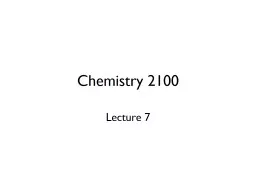

Amines Amines are nitrogencontaining compounds Structure and Classification Amines are classified as 1 2 or 3 depending on the number of carbon groups bonded to nitrogen Aliphatic amine ID: 914265
Download Presentation The PPT/PDF document "Chemistry 2100 Chapter 16" is the property of its rightful owner. Permission is granted to download and print the materials on this web site for personal, non-commercial use only, and to display it on your personal computer provided you do not modify the materials and that you retain all copyright notices contained in the materials. By downloading content from our website, you accept the terms of this agreement.
Slide1
Chemistry 2100
Chapter 16
Slide2Amines
Amines are nitrogen-containing compounds
Slide3Structure and Classification
Amines are classified as 1°, 2°, or 3° depending on the number of carbon groups bonded to nitrogen.
Aliphatic amine:
All carbons bonded to nitrogen are derived from alkyl groups. See the three above.
Aromatic amine:
One or more of the groups bonded to nitrogen are aryl groups.
Slide4Structure and Classification
Heterocyclic amine:
An amine in which the nitrogen atom is part of a ring.
Heterocyclic aliphatic amine:
A heterocyclic amine in which the ring is saturated (has no C=C bonds).
Heterocyclic aromatic amine:
The amine nitrogen is part of an aromatic ring.
Slide5Nomenclature
IUPAC names
We derive IUPAC names for aliphatic amines just as we did for alcohols.
Drop the final
-e
of the parent alkane and replace it by
-amine.Use a number to locate the amino group on the parent chain.
Slide6Physical Properties
Amines are polar compounds:
Both 1° and 2° amines have N-H bonds, and can form hydrogen bonds with one another.
3° Amines have no N-H bond and cannot form hydrogen bonds with one another.
Slide7CH
3
CH
2
CH
2
N
H
2
(bp 48°C)
CH
3
CH
2
N
H
CH
3 (bp 35°C) (CH3)3N (bp 3°C)
CH3CH3 (bp -88°C) CH3NH2 (bp -7°C) CH3OH (bp +65°C)
NH3 (bp -33°C) H2O (bp +100°C)
Boiling Points
Slide8Odor
Like ammonia, low-molecular-weight amines have very sharp, penetrating odors.
Trimethylamine, for example, is the pungent principle in the smell of rotting fish.
Two other particularly pungent amines are 1,4-butanediamine (putrescine) and 1,5-pentanediamine (cadaverine).
Slide9Basicity of Amines
Slide10free base
ammonium salt
(hydrochloride)
Ammonium Salts
Slide11(S)-
(+)-coniine
(S)-
(–)-nicotine
(–)-strychnine
(–)-cocaine hydrochloride
Alkaloids
Slide12Nitrosation
Slide13Slide14Slide15Slide16Slide17Slide18Slide19Slide20Azo Dyes
Slide21Slide22Slide23Slide24Orange II
Slide25Orange II
Slide26Orange II
Slide27Orange II
American Flag Red
Slide28Slide29Slide30Heterocyclic Amines
Slide31Slide32nicotinamide / niacin (B
3
)
Slide33Morphine
Codeine
Heroin
Slide34Poison Dart Frogs